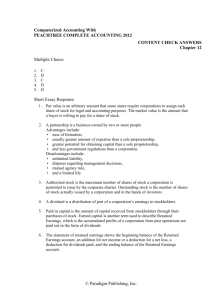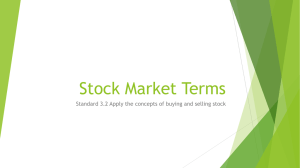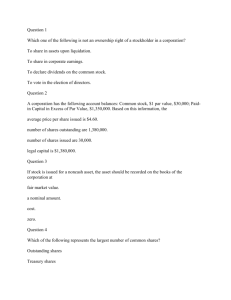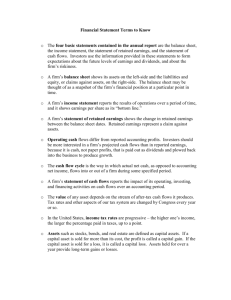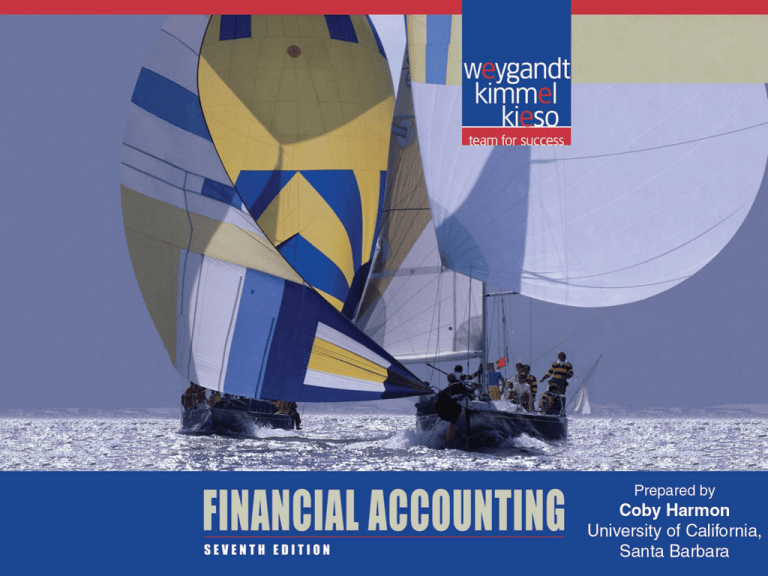
Slide
13-1
Chapter
11
Corporations:
Organization, Stock
Transactions, Dividends, and
Retained Earnings
Financial Accounting,
Seventh Edition
Slide
13-2
Study Objectives
1.
Identify the major characteristics of a corporation.
2.
Record the issuance of common stock.
3.
Explain the accounting for treasury stock.
4.
Differentiate preferred stock from common stock.
5.
Prepare the entries for cash dividends and stock dividends.
6.
Identify the items that are reported in a retained earnings
statement.
7.
Prepare and analyze a comprehensive stockholders’ equity
section.
Slide
13-3
Corporations: Organization, Stock Transactions,
Dividends, and Retained Earnings
Corporate
Organization and
Stock
Transactions
Dividends
Corporate form of
organization
Cash dividends
Common stock
issues
Stock splits
Treasury stock
Preferred stock
Slide
13-4
Stock dividends
Retained
Earnings
Retained earnings
restrictions
Prior period
adjustments
Retained earnings
statement
Statement
Presentation and
Analysis
Presentation
Analysis
The Corporate Form of Organization
An entity separate and distinct from its owners.
Classified by Purpose
Not-for-Profit
Publicly held
For Profit
Privately held
Salvation Army
American Cancer
Society
Gates Foundation
Slide
13-5
Classified by Ownership
McDonald’s
Ford Motor Company
PepsiCo
Google
Cargill Inc.
The Corporate Form of Organization
Characteristics that distinguish corporations from
proprietorships and partnerships.
Separate Legal Existence
Limited Liability of Stockholders
Transferable Ownership Rights
Ability to Acquire Capital
Advantages
Continuous Life
Corporate Management
Government Regulations
Disadvantages
Additional Taxes
Slide
13-6
SO 1 Identify the major characteristics of a corporation.
Characteristics of a Corporation
Characteristics that distinguish corporations from
proprietorships and partnerships.
Separate Legal Existence
Limited Liability of Stockholders
Transferable Ownership Rights
Ability to Acquire Capital
Corporation acts
under its own name
rather than in the
name of its
stockholders.
Continuous Life
Corporate Management
Government Regulations
Additional Taxes
Slide
13-7
SO 1 Identify the major characteristics of a corporation.
Characteristics of a Corporation
Characteristics that distinguish corporations from
proprietorships and partnerships.
Separate Legal Existence
Limited Liability of Stockholders
Transferable Ownership Rights
Limited to their
investment.
Ability to Acquire Capital
Continuous Life
Corporate Management
Government Regulations
Additional Taxes
Slide
13-8
SO 1 Identify the major characteristics of a corporation.
Characteristics of a Corporation
Characteristics that distinguish corporations from
proprietorships and partnerships.
Separate Legal Existence
Limited Liability of Stockholders
Transferable Ownership Rights
Ability to Acquire Capital
Shareholders may
sell their stock.
Continuous Life
Corporate Management
Government Regulations
Additional Taxes
Slide
13-9
SO 1 Identify the major characteristics of a corporation.
Characteristics of a Corporation
Characteristics that distinguish corporations from
proprietorships and partnerships.
Separate Legal Existence
Limited Liability of Stockholders
Transferable Ownership Rights
Ability to Acquire Capital
Continuous Life
Corporate Management
Corporation can
obtain capital
through the
issuance of stock.
Government Regulations
Additional Taxes
Slide
13-10
SO 1 Identify the major characteristics of a corporation.
Characteristics of a Corporation
Characteristics that distinguish corporations from
proprietorships and partnerships.
Separate Legal Existence
Limited Liability of Stockholders
Transferable Ownership Rights
Ability to Acquire Capital
Continuous Life
Corporate Management
Government Regulations
Additional Taxes
Slide
13-11
Continuance as a
going concern is not
affected by the
withdrawal, death,
or incapacity of a
stockholder,
employee, or
officer.
SO 1 Identify the major characteristics of a corporation.
Characteristics of a Corporation
Characteristics that distinguish corporations from
proprietorships and partnerships.
Separate Legal Existence
Limited Liability of Stockholders
Transferable Ownership Rights
Ability to Acquire Capital
Continuous Life
Corporate Management
Government Regulations
Additional Taxes
Slide
13-12
Separation of
ownership and
management prevents
owners from having
an active role in
managing the
company.
SO 1 Identify the major characteristics of a corporation.
Characteristics of a Corporation
Characteristics that distinguish corporations from
proprietorships and partnerships.
Separate Legal Existence
Limited Liability of Stockholders
Transferable Ownership Rights
Ability to Acquire Capital
Continuous Life
Corporate Management
Government Regulations
Additional Taxes
Slide
13-13
SO 1 Identify the major characteristics of a corporation.
Characteristics of a Corporation
Characteristics that distinguish corporations from
proprietorships and partnerships.
Separate Legal Existence
Limited Liability of Stockholders
Transferable Ownership Rights
Ability to Acquire Capital
Continuous Life
Corporate Management
Government Regulations
Additional Taxes
Slide
13-14
Corporations pay
income taxes as a
separate legal entity
and in addition,
stockholders pay
taxes on cash
dividends.
SO 1 Identify the major characteristics of a corporation.
Characteristics of a Corporation
Stockholders
Illustration 11-1
Corporation organization
chart
Chairman and
Board of
Directors
President and
Chief Executive
Officer
General
Counsel and
Secretary
Vice President
Marketing
Treasurer
Slide
13-15
Vice President
Finance/Chief
Financial Officer
Vice President
Operations
Vice President
Human
Resources
Controller
SO 1 Identify the major characteristics of a corporation.
Slide
13-16
Forming a Corporation
Initial Steps:
File application with the Secretary of State.
State grants charter.
Corporation develops by-laws.
Companies generally incorporate in a state whose laws
are favorable to the corporate form of business
(Delaware, New Jersey).
Corporations expense organization costs as incurred.
Slide
13-17
SO 1 Identify the major characteristics of a corporation.
Ownership Rights of Stockholders
Stockholders have the right to:
Illustration 11-3
1. Vote in election of board of
directors and on actions that
require stockholder approval.
2. Share the corporate earnings
through receipt of dividends.
Slide
13-18
SO 1 Identify the major characteristics of a corporation.
Ownership Rights of Stockholders
Stockholders have the right to:
Illustration 11-3
3. Keep the same percentage ownership when new
shares of stock are issued (preemptive right*).
* A number of companies have eliminated the preemptive right.
Slide
13-19
SO 1 Identify the major characteristics of a corporation.
Ownership Rights of Stockholders
Stockholders have the right to:
Illustration 11-3
4. Share in assets upon liquidation in proportion to
their holdings. This is called a residual claim.
Slide
13-20
SO 1 Identify the major characteristics of a corporation.
Ownership Rights of Stockholders
Prenumbered
Illustration 11-4
Class
Class A
Class A
COMMON STOCK
COMMON STOCK
PAR VALUE
$1 PER SHARE
PAR VALUE
$1 PER SHARE
Name of corporation
Stockholder’s name
Stock Certificate
Shares
Signature of
corporate official
Slide
13-21
SO 1 Identify the major characteristics of a corporation.
Stock Issue Considerations
Authorized Stock
Charter indicates the amount of stock that a
corporation is authorized to sell.
Number of authorized shares is often reported in
the stockholders’ equity section.
Slide
13-22
SO 1 Identify the major characteristics of a corporation.
Stock Issue Considerations
Issuance of Stock
Corporation can issue common stock directly to
investors or indirectly through an investment banking
firm.
Factors in setting price for a new issue of stock:
1. the company’s anticipated future earnings
2. its expected dividend rate per share
3. its current financial position
4. the current state of the economy
5. the current state of the securities market
Slide
13-23
SO 1 Identify the major characteristics of a corporation.
Stock Issue Considerations
Market Value of Stock
Stock of publicly held companies is traded on organized
exchanges.
Interaction between buyers and sellers determines the
prices per share.
Prices set by the marketplace tend to follow the trend
of a company’s earnings and dividends.
Factors beyond a company’s control, may cause day-today fluctuations in market prices.
Slide
13-24
SO 1 Identify the major characteristics of a corporation.
Slide
13-25
Stock Issue Considerations
Par and No-Par Value Stock
Years ago, par value determined the legal capital per
share that a company must retain in the business for
the protection of corporate creditors.
Today many states do not require a par value.
No-par value stock is quite common today.
In many states the board of directors assigns a stated
value to no-par shares.
Slide
13-26
SO 1 Identify the major characteristics of a corporation.
Corporate Capital
Common Stock
Paid-in Capital
Account
Preferred Stock
Paid-in Capital in
Excess of Par
Account
Account
Two Primary
Sources of
Equity
Retained Earnings
Account
Paid-in capital is the total amount of cash and other assets
paid in to the corporation by stockholders in exchange for
capital stock.
Slide
13-27
SO 1 Identify the major characteristics of a corporation.
Corporate Capital
Common Stock
Paid-in Capital
Account
Preferred Stock
Additional Paidin Capital
Account
Account
Two Primary
Sources of
Equity
Retained Earnings
Account
Retained earnings is net income that a corporation retains
for future use.
Slide
13-28
SO 1 Identify the major characteristics of a corporation.
Corporate Capital
Comparison of the owners’ equity (stockholders’
equity) accounts reported on a balance sheet for a
proprietorship and a corporation.
Illustration 11-6
Slide
13-29
SO 1 Identify the major characteristics of a corporation.
Corporate Capital
At the end of its first year of operation, Doral
Corporation has $750,000 of common stock and
net income of $122,000. Prepare (a) the closing entry for net
income and (b) the stockholders’ equity section at year-end.
Slide
13-30
Solution on
notes page
SO 1 Identify the major characteristics of a corporation.
Accounting for Common Stock Issues
Primary objectives:
1) Identify the specific sources of paid-in capital.
2) Maintain the distinction between paid-in capital
and retained earnings.
Other than consideration received, the
issuance of common stock affects only
paid-in capital accounts.
Slide
13-31
SO 2 Record the issuance of common stock.
Accounting for Common Stock Issues
Issuing Par Value Common Stock for Cash
Illustration: Assume that Hydro-Slide, Inc. issues 2,000
shares of $1 par value common stock. Prepare Hydro-Slide’s
journal entry if (a) 1,000 share are issued for $1 per share,
and (b) 1,000 shares are issued for $5 per share.
a.
Cash
1,000
Common stock (1,000 x $1)
b.
Slide
13-32
Cash
1,000
5,000
Common stock (1,000 x $1)
1,000
Paid-in capital in excess of par value
4,000
SO 2 Record the issuance of common stock.
Accounting for Common Stock Issues
Illustration 11-7
Slide
13-33
SO 2 Record the issuance of common stock.
Accounting for Common Stock Issues
Issuing No-Par Common Stock for Cash
Illustration: Assume that Hydro-Slide, Inc. issues 5,000
shares of $5 stated value no-par common stock for $8 per
share. The entry is:
Cash
40,000
Common stock (5,000 x $5)
25,000
Paid-in capital in excess of stated value
15,000
Prepare the entry assuming there is no stated value?
Cash
Common stock
Slide
13-34
40,000
40,000
SO 2 Record the issuance of common stock.
Accounting for Common Stock Issues
Issuing Common Stock for Services or
Noncash Assets
Corporations also may issue stock for:
Services (attorneys or consultants).
Noncash assets (land, buildings, and equipment).
Cost is either the fair market value of the consideration
given up, or the fair market value of the consideration
received, whichever is more clearly determinable.
Slide
13-35
SO 2 Record the issuance of common stock.
Accounting for Common Stock Issues
Illustration: Assume that attorneys have helped Jordan
Company incorporate. They have billed the company $5,000
for their services. They agree to accept 4,000 shares of $1
par value common stock in payment of their bill. At the time
of the exchange, there is no established market price for the
stock. Prepare the journal entry for this transaction.
Organizational expense
Slide
13-36
5,000
Common stock (4,000 x $1)
4,000
Paid-in capital in excess of par
1,000
SO 2 Record the issuance of common stock.
Accounting for Common Stock Issues
Illustration: Assume that Athletic Research Inc. is an
existing publicly held corporation. Its $5 par value stock is
actively traded at $8 per share. The company issues 10,000
shares of stock to acquire land recently advertised for sale
at $90,000. Prepare the journal entry for this transaction.
Land (10,000 x $8)
Slide
13-37
80,000
Common stock (10,000 x $5)
50,000
Paid-in capital in excess of par
30,000
SO 2 Record the issuance of common stock.
Accounting for Treasury Stock
Common Stock
Paid-in Capital
Account
Preferred Stock
Paid-in Capital in
Excess of Par
Account
Account
Two Primary
Sources of
Equity
Retained Earnings
Account
Less:
Treasury Stock
Account
Slide
13-38
SO 3 Explain the accounting for treasury stock.
Accounting for Treasury Stock
Treasury stock - corporation’s own stock that it has
reacquired from shareholders, but not retired.
Corporations purchase their outstanding stock:
1.
To reissue the shares to officers and employees under bonus
and stock compensation plans.
2. To enhance the stock’s market value.
3. To have additional shares available for use in the acquisition
of other companies.
4. To increase earnings per share.
5. To rid the company of disgruntled investors, perhaps to avoid
a takeover.
Slide
13-39
SO 3 Explain the accounting for treasury stock.
Accounting for Treasury Stock
Purchase of Treasury Stock
Debit Treasury Stock for the price paid to reacquire
the shares.
Treasury stock is a contra stockholders’ equity
account, not an asset.
Purchase of treasury stock reduces stockholders’
equity.
Slide
13-40
SO 3 Explain the accounting for treasury stock.
Accounting for Treasury Stock
Illustration 11-8
Illustration: On February 1, 2011, Mead acquires 4,000
shares of its stock at $8 per share.
Treasury stock (4,000 x $8)
Cash
Slide
13-41
32,000
32,000
SO 3 Explain the accounting for treasury stock.
Accounting for Treasury Stock
Stockholders’ Equity with Treasury stock
Illustration 11-9
Both the number of shares issued (100,000), outstanding (96,000), and
the number of shares held as treasury (4,000) are disclosed.
Slide
13-42
SO 3 Explain the accounting for treasury stock.
Slide
13-43
Accounting for Treasury Stock
Disposal of Treasury Stock
Above Cost
Below Cost
Both increase total assets and stockholders’
equity.
Slide
13-44
SO 3 Explain the accounting for treasury stock.
Above
Cost
Accounting for Treasury Stock
Illustration: On February 1, 2011, Mead acquired 4,000
shares of its stock at $8 per share.
On July 1, Mead sells for $10 per share 1,000 shares of its
treasury stock, previously acquired at $8 per share.
July 1
Cash
10,000
Treasury stock (1,000 x $8)
Paid-in capital treasury stock
8,000
2,000
A corporation does not realize a gain or suffer a loss from stock
transactions with its own stockholders.
Slide
13-45
SO 3 Explain the accounting for treasury stock.
Below
Cost
Accounting for Treasury Stock
Illustration: On February 1, 2011, Mead acquired 4,000
shares of its stock at $8 per share.
On Oct. 1, Mead sells an additional 800 shares of treasury
stock at $7 per share.
Oct. 1
Cash
5,600
Paid-in capital treasury stock
Treasury stock (800 x $8)
800
6,400
Mead uses Paid-in Capital from Treasury Stock, if available, for the
difference between cost and resale price of the shares.
Slide
13-46
SO 3 Explain the accounting for treasury stock.
Below
Cost
Accounting for Treasury Stock
Illustration: On February 1, 2011, Mead acquired 4,000
shares of its stock at $8 per share.
On Dec. 1, assume that Mead, Inc. sells its remaining 2,200
shares at $7 per share.
Dec. 1
Cash
15,400
Paid-in capital treasury stock
1,200
Retained earnings
1,000
Treasury stock (2,200 x $8)
Slide
13-47
Limited
to
balance
on hand
17,600
SO 3 Explain the accounting for treasury stock.
Preferred Stock
Features often associated with preferred stock.
1.
Preference as to dividends.
2.
Preference as to assets in liquidation.
3.
Nonvoting.
Accounting for preferred stock at issuance is similar to
that for common stock.
Slide
13-48
SO 4 Differentiate preferred stock from common stock.
Preferred Stock
Illustration: Stine Corporation issues 10,000 shares of
$10 par value preferred stock for $12 cash per share.
Journalize the issuance of the preferred stock.
Cash
120,000
Preferred stock (10,000 x $10)
100,000
Paid-in capital in excess of par –
Preferred stock
20,000
Preferred stock may have a par value or no-par value.
Slide
13-49
SO 4 Differentiate preferred stock from common stock.
Preferred Stock
Dividend Preferences
Right to receive dividends before common
stockholders.
Per share dividend amount is stated as a percentage
of the preferred stock’s par value or as a specified
amount.
Cumulative dividend – holders of preferred stock
must be paid their annual dividend plus any dividends
in arrears before common stockholders receive
dividends.
Slide
13-50
SO 4 Differentiate preferred stock from common stock.
Dividends
A distribution of cash or stock to stockholders on a
pro rata (proportional) basis.
Types of Dividends:
1.
Cash dividends.
2. Property dividends.
3. Scrip (note)
4. Stock dividends.
Dividends expressed: (1) as a percentage of the par or
stated value, or (2) as a dollar amount per share.
Slide
13-51
SO 5 Prepare the entries for cash dividends and stock dividends.
Dividends
Dividends require information concerning three dates:
Illustration 11-12
Slide
13-52
SO 5 Prepare the entries for cash dividends and stock dividends.
Cash Dividends
Cash Dividends
For a corporation to pay a cash dividend, it must have:
1. Retained earnings - Payment of cash dividends from
retained earnings is legal in all states.
2. Adequate cash.
3. A declaration of dividends by the Board of Directors.
Slide
13-53
SO 5 Prepare the entries for cash dividends and stock dividends.
Cash Dividends
Illustration: On Dec. 1, the directors of Media General
declare a 50¢ per share cash dividend on 100,000 shares of
$10 par value common stock. The dividend is payable on Jan.
20 to shareholders of record on Dec. 22?
December 1 (Declaration Date)
Retained earnings
Dividends payable
December 22 (Date of Record)
50,000
50,000
No entry
January 20 (Payment Date)
Dividends payable
Cash
Slide
13-54
50,000
50,000
SO 5 Prepare the entries for cash dividends and stock dividends.
Cash Dividends
Allocating Cash Dividends Between Preferred
and Common Stock
Holders of cumulative preferred stock must be paid
any unpaid prior-year dividends before common
stockholders receive dividends.
Slide
13-55
SO 5 Prepare the entries for cash dividends and stock dividends.
Cash Dividends
Illustration: On December 31, 2011, IBR Inc. has 1,000
shares of 8%, $100 par value cumulative preferred stock. It
also has 50,000 shares of $10 par value common stock
outstanding. At December 31, 2011, the directors declare a
$6,000 cash dividend. Prepare the entry to record the
declaration of the dividend.
Retained earnings
6,000
Dividends payable
6,000
Pfd Dividends: 1,000 shares x $100 par x 8% = $8,000
Slide
13-56
SO 5 Prepare the entries for cash dividends and stock dividends.
Cash Dividends
Illustration: At December 31, 2012, IBR declares a $50,000
cash dividend. Show the allocation of dividends to each class
of stock.
2011
Dividends declared
$
6,000
Dividends in arrears
Allocation to preferred
Remainder to common
6,000
$
-
2012
$ 50,000
2,000 **
8,000 *
$ 40,000
* 1,000 shares x $100 par x 8% = $8,000
** 2010 Pfd. dividends $8,000 – declared $6,000 = $2,000
Slide
13-57
SO 5 Prepare the entries for cash dividends and stock dividends.
Cash Dividends
Illustration: At December 31, 2012, IBR declares a $50,000
cash dividend. Prepare the entry to record the declaration of
the dividend.
Retained earnings
Dividends payable
Slide
13-58
50,000
50,000
SO 5 Prepare the entries for cash dividends and stock dividends.
Slide
13-59
Stock Dividends
Stock Dividends
Illustration 11-14
Pro rata distribution of the corporation’s own stock.
Results in decrease in retained earnings and increase in paid-in capital.
Slide
13-60
SO 5 Prepare the entries for cash dividends and stock dividends.
Stock Dividends
Stock Dividends
Reasons why corporations issue stock dividends:
1. To satisfy stockholders’ dividend expectations without
spending cash.
2. To increase the marketability of the corporation’s
stock.
3. To emphasize that a portion of stockholders’ equity has
been permanently reinvested in the business.
Slide
13-61
SO 5 Prepare the entries for cash dividends and stock dividends.
Stock Dividends
Size of Stock Dividends
Small stock dividend (less than 20–25% of the
corporation’s issued stock, recorded at fair
market value) *
Large stock dividend (greater than 20–25% of
issued stock, recorded at par value)
* This accounting is based on the assumption that a small
stock dividend will have little effect on the market price of
the outstanding shares.
Slide
13-62
SO 5 Prepare the entries for cash dividends and stock dividends.
Stock Dividends
Illustration: Medland Corp. has 50,000 shares issued and
outstanding. The par value is $10 per share and market
value is $15 per share.
10% stock dividend is declared
Retained earnings
(50,000 x 10% x $15)
Common stock dividends distributable
Paid-in capital in excess of par value
75,000
50,000
25,000
Stock issued
Common stock dividends distributable
Common stock
Slide
13-63
50,000
50,000
SO 5 Prepare the entries for cash dividends and stock dividends.
Stock Dividends
Stockholders’ Equity with Dividends Distributable
Illustration 11-15
Medland Corporation
Balance Sheet (partial)
Stockholders' equity
Paid-in capital
Common stock
Common stock dividends distributable
Total stockholders' equity
Slide
13-64
$ 500,000
50,000
$ 550,000
SO 5 Prepare the entries for cash dividends and stock dividends.
Stock Dividends
Effects of Stock Dividends
Illustration 11-16
Slide
13-65
SO 5 Prepare the entries for cash dividends and stock dividends.
Stock Dividends
Question
Which of the following statements about small stock
dividends is true?
a. A debit to Retained Earnings for the par value of
the shares issued should be made.
b. A small stock dividend decreases total stockholders’
equity.
c. Market value per share should be assigned to the
dividend shares.
d. A small stock dividend ordinarily will have no effect
on book value per share of stock.
Slide
13-66
SO 5 Prepare the entries for cash dividends and stock dividends.
Stock Dividends
Question
In the stockholders’ equity section, Common Stock
Dividends Distributable is reported as a(n):
a. deduction from total paid-in capital and retained
earnings.
b. current liability.
c. deduction from retained earnings.
d. addition to capital stock.
Slide
13-67
SO 5 Prepare the entries for cash dividends and stock dividends.
Stock Splits
Stock Split
Reduces the market value of shares.
No entry recorded for a stock split.
Decrease par value and increase number of
shares.
Slide
13-68
SO 5 Prepare the entries for cash dividends and stock dividends.
Stock Splits
Illustration: Assume Medland Corporation splits its
50,000 shares of common stock on a 2-for-1 basis.
Illustration 11-17
Results in a reduction of the par or stated value per share.
Slide
13-69
SO 5 Prepare the entries for cash dividends and stock dividends.
Retained Earnings
Retained earnings is net income that a company
retains for use in the business.
Net income increases Retained Earnings and a net
loss decreases Retained Earnings.
Retained earnings is part of the stockholders’ claim
on the total assets of the corporation.
A debit balance in Retained Earnings is identified as
a deficit.
Slide
13-70
SO 6 Identify the items reported in a retained earnings statement.
Retained Earnings Restrictions
Restrictions can result from:
1. Legal restrictions.
2. Contractual restrictions.
3. Voluntary restrictions.
Illustration 11-22
Slide
13-71
SO 6 Identify the items reported in a retained earnings statement.
Prior Period Adjustments
Corrections of Errors
Result from:
mathematical mistakes
mistakes in application of accounting principles
oversight or misuse of facts
Corrections treated as prior period adjustments
Adjustment made to the beginning balance of
retained earnings
Slide
13-72
SO 6 Identify the items reported in a retained earnings statement.
Prior Period Adjustments
Woods, Inc.
Statement of Retained Earnings
For the Year Ended December 31, 2011
Balance, January 1
Net income
Dividends
Balance, December 31
$
$
1,050,000
360,000
(300,000)
1,110,000
Before issuing the report for the year ended December 31, 2011, you discover a
$50,000 error (net of tax) that caused the 2010 inventory to be overstated
(overstated inventory caused COGS to be lower and thus net income to be
higher in 2010. Would this discovery have any impact on the reporting of the
Statement of Retained Earnings for 2011?
Slide
13-73
SO 6 Identify the items reported in a retained earnings statement.
Prior Period Adjustments
Woods, Inc.
Statement of Retained Earnings
For the Year Ended December 31, 2011
Balance, January 1, as previously reported
Prior period adjustment - error correction
Balance, January 1, as restated
Net income
Dividends
Balance, December 31
Slide
13-74
$
$
1,050,000
(50,000)
1,000,000
360,000
(300,000)
1,060,000
SO 6 Identify the items reported in a retained earnings statement.
Retained Earnings Statement
The company prepares the statement from the Retained
Earnings account.
Illustration 11-24
Slide
13-75
SO 6 Identify the items reported in a retained earnings statement.
Retained Earnings Statement
Illustration 11-25
Slide
13-76
SO 6 Identify the items reported in a retained earnings statement.
Retained Earnings Statement
Question
All but one of the following is reported in a retained
earnings statement. The exception is:
a. cash and stock dividends.
b. net income and net loss.
c. some disposals of treasury stock below cost.
d. sales of treasury stock above cost.
Slide
13-77
SO 6 Identify the items reported in a retained earnings statement.
Statement Presentation and Analysis
Illustration 11-26
Slide
13-78
SO 7
Statement Analysis and Presentation
Analysis
Return on
Common
Stockholders’
Equity
=
Net Income Available
to Common Stockholders
Average Common
Stockholders’ Equity
This ratio shows how many dollars of net income the
company earned for each dollar invested by the
stockholders.
Slide
13-79
SO 7 Prepare and analyze a comprehensive stockholders’ equity section.
Statement Analysis and Presentation
Analysis
Illustration: Kellogg Company’s beginning-of-the-year and
end-of-the-year common stockholders’ equity were $2,526
and $1,448 million, respectively. Its net income was $1,148
million, and no preferred stock was outstanding. The
return on common stockholders’ equity ratio is computed
as follows.
Illustration 11-28
Slide
13-80
Solution on
notes page
SO 7 Prepare and analyze a comprehensive stockholders’ equity section.
Home-Equity Loans
Home-equity loans are now difficult to get. The reasons are that
banks are not making the loans, and sinking home prices give
homeowners less equity to borrow against.
Four major reasons why many individuals employ home-equity loans
are: (1) to invest, (2) to get a tax deduction, (3) to defer other
debt, or (4) to buy from a wish list.
Slide
13-81
While home-equity loans tend to have fixed rates, home-equity
lines of credit, which allow the homeowner to borrow up to a
certain amount whenever they want to, have variable rates. Rates
on home-equity lines of credit averaged 8.33% in April 2006,
versus about 14% for credit card debt.
Home-equity loan interest is tax-deductible (like home mortgage
interest). Interest on car loans, most student loans, and credit
cards is not.
Slide
13-82
Home-equity loans can be
very tempting. Suppose
that you wanted to
borrow $5,000
to take a vacation. You
could spread your
payments over 15 years
and you would have
to pay only about $50
per month. But look what
your total payments
would be over the
life of the 15-year loan.
Some vacation!
Slide
13-83
Your home has increased in value by $50,000 during the last
five years. You have very little savings outside of the equity
in your home. You desperately need a vacation, and you are
considering taking out a $5,000 home-equity loan to finance
a two-week dream vacation in Europe. Is this is a bad idea?
YES: This represents a significant portion of your savings.
Home-equity loans should be used to finance investments of
a lasting nature, not items of a fleeting nature like
vacations.
NO: You need a vacation. If you use a little of the equity in
your home now, you can make it up when your house
increases in value in the future.
Slide
13-84
Stockholders’ Equity Statement
Appendix 11A
Illustration 11A-1
When a stockholders’ equity statement is presented, a retained
earnings statement is not necessary.
Slide
13-85
SO 8 Describe the use and content of the stockholders’’ statement.
Book Value—Another Per-Share Amount
Book Value per Share
Appendix 11B
The equity a common stockholder has in the net assets of
the corporation.
Illustration 11B-1
Slide
13-86
SO 9 Compute book value per share.
Book Value—Another Per-Share Amount
Book Value per Share
Appendix 11B
The computation of book value per share involves the
following steps.
1.
Compute the preferred stock equity. This equity is equal to
the sum of the call price of preferred stock plus any
cumulative dividends in arrears. If the preferred stock does
not have a call price, the par value of the stock is used.
2. Determine the common stock equity. Subtract the preferred
stock equity from total stockholders’ equity.
3. Determine book value per share. Divide common stock equity
by shares of common stock outstanding.
Slide
13-87
SO 9 Compute book value per share.
Book Value—Another Per-Share Amount
Appendix 11B
Illustration: using the stockholders’ equity section of Graber
Inc. shown in Illustration 11-26. Graber’s preferred stock is
callable at $120 per share and is cumulative. Assume that
dividends on Graber’s preferred stock were in arrears for one
year, $54,000 (6,000 $9). The computation of preferred stock
equity (Step 1 in the preceding list) is:
Illustration 11B-2
Slide
13-88
SO 9 Compute book value per share.
Book Value—Another Per-Share Amount
Illustration 11B-2
Computation of book value:
Slide
13-89
Illustration 11B-3
SO 9 Compute book value per share.
Book Value—Another Per-Share Amount
Book Value versus Market Value
Appendix 11B
The correlation between book value and the annual range of a
company’s market value per share is often remote.
Illustration 11B-4
Slide
13-90
SO 9 Compute book value per share.
Copyright
“Copyright © 2010 John Wiley & Sons, Inc. All rights reserved.
Reproduction or translation of this work beyond that permitted
in Section 117 of the 1976 United States Copyright Act without
the express written permission of the copyright owner is
unlawful. Request for further information should be addressed
to the Permissions Department, John Wiley & Sons, Inc. The
purchaser may make back-up copies for his/her own use only
and not for distribution or resale. The Publisher assumes no
responsibility for errors, omissions, or damages, caused by the
use of these programs or from the use of the information
contained herein.”
Slide
13-91


